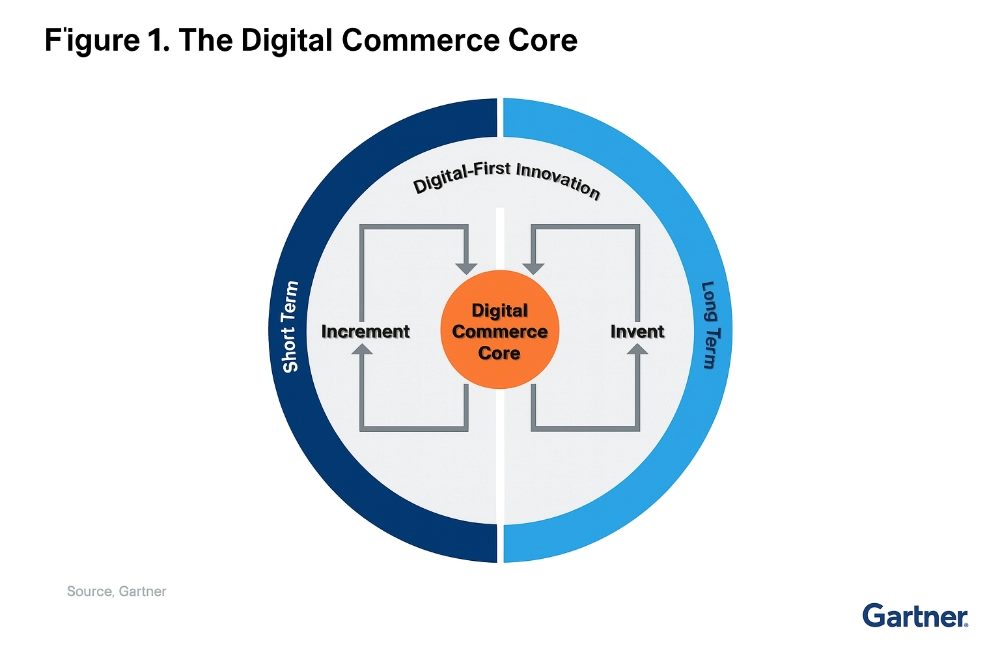The Gist
- Short-term thinking limits growth. Many leaders view digital commerce as a short-term revenue driver rather than a long-term growth engine.
- Three models for strategic growth. CMOs can build effective strategies using core development, incremental innovation, and invention frameworks.
- Future-proofing requires reinvention. Companies that invent through digital commerce are better prepared for disruption and market shifts.
Digital commerce has grown rapidly, fueled by evolving customer behaviors in both the B2C and B2B sectors. However, while most organizational leaders recognize the importance of digital commerce, many still view it as a short-term driver of commercial results, leading to a focus on immediate gains rather than long-term transformation.
Why CMOs Must Lead the Strategic Shift
For CMOs, overcoming this short-term mindset is crucial. They must reposition digital commerce as a strategic growth engine capable of meeting changing customer expectations and driving sustained business success. There are three digital commerce growth models that CMOs can leverage to develop a growth strategy that delivers both short and long term results.
Comparison of Digital Commerce Growth Models
Each model supports a different level of maturity and innovation, helping CMOs align strategy with customer needs and market realities.
| Model | Primary Focus | Best For | Strategic Benefit |
|---|---|---|---|
| Digital Commerce Core | Strengthening existing brands, products, and channels | B2C and B2B firms with a strong foundation | Maximizes profitability and operational excellence |
| Increment Model | Testing enhancements and new digital channels | Risk-averse organizations seeking gradual growth | Enables controlled experimentation and innovation |
| Invention Model | Creating entirely new digital business models | Forward-looking firms with appetite for disruption | Develops diversified revenue streams for long-term success |
Table of Contents
- Solidify the Digital Commerce Core
- Establish Incremental Digital Commerce Innovation
- Invent Through Digital Commerce
- Core Questions About Digital Commerce Growth Models
Solidify the Digital Commerce Core
As competition intensifies in the digital commerce landscape, B2C companies are under pressure to sustain digital growth even as customers return to offline channels.
Meanwhile, B2B firms are only beginning to tap into digital opportunities, often hindered by limited maturity. At the heart of a successful digital commerce strategy lies the digital commerce core model, which establishes the foundational priorities and initiatives needed to win customers and outpace competitors. This model emphasizes growing the core business by focusing on priority brands, products, services, and routes to market, all aimed at maximizing revenue and profit:

Define What Belongs in the Digital Commerce Core
The composition of the digital commerce core varies by organization, shaped by customer expectations, growth potential and industry maturity. To succeed, organizations must build on their existing brand and product portfolios, allocate resources strategically and execute with excellence across paid, earned and owned digital channels.
Continual investment in digital capabilities—such as talent development, partner ecosystems and technology—is essential. By defining the scope of their digital commerce core, setting clear priorities and building robust plans to outperform competitors, organizations can consistently achieve revenue and profit targets, maximize their digital opportunities and secure a leading position in a rapidly evolving marketplace.
Related Article: The Future of Ecommerce: Creating Blended Experiences
Establish Incremental Digital Commerce Innovation
Shifting customer behaviors and expectations demand that both B2C and B2B CMOs embrace innovation. The increment model provides a structured approach to building on the digital commerce core by introducing enhancements and experimentation—such as launching products or services exclusively through digital channels or testing emerging channels like social commerce.
Drive Measured Innovation with Minimal Risk
This model is particularly valuable for risk-averse organizations, as it allows for controlled, incremental innovation that can be tailored to either growth or defense strategies. Initiatives can range from small-scale test-and-learn experiments woven into daily operations to larger projects requiring dedicated teams. The key is to focus on opportunities where there is a strong customer value proposition and the capability to pivot into new segments, always maintaining a customer-centric mindset.
Invent Through Digital Commerce
Some organizations overlook digital commerce as a vehicle to create new value propositions that address white space opportunities or looming strategic threats. This oversight is often rooted in short-term thinking or skepticism about the long-term promise of digital commerce, as well as the inherent challenges and risks associated with digital commerce invention.
Create New Value Propositions with Invention
To successfully invent new digital commerce propositions, companies must adopt a fundamentally different mindset, governance structure and process from their core business. This involves a willingness to take calculated risks, invest disproportionately and nurture initiatives over the long term. CMOs should selectively pursue invention where there is a clear whitespace opportunity or a critical need to adapt for future survival, such as launching new business models, direct-to-customer brands or digital marketplaces.
Ultimately, organizations that embrace ongoing exploration, set clear criteria for invention and align stakeholder expectations are better positioned to develop diversified digital revenue streams and future-proof their business.
Core Questions About Digital Commerce Growth Models
Editor's note: The digital commerce market reached $9.98 billion in software revenue in 2023, showing an 11.2% year-over-year growth, according to Gartner. Many CMOs recognize the value of digital commerce — but fail to build long-term strategies around it. These questions clarify the three key models leaders can adopt to ensure both sustainable innovation and market resilience.
Through incremental innovation — testing new channels or exclusive offerings in low-risk environments. These "test and learn" models integrate with existing operations and inform future strategy.
A prioritized set of brands, products, services and channels that generate profitable growth. It requires strategic resource allocation and continuous investment in capabilities.
A new governance model, high tolerance for ambiguity and willingness to invest in long-term bets. CMOs must align stakeholders and target whitespace opportunities with strong value propositions.
It limits the ability to invest in infrastructure, innovation and long-term value creation. Focusing only on quick wins misses the opportunity to shape future growth and customer loyalty.
Learn how you can join our contributor community.
